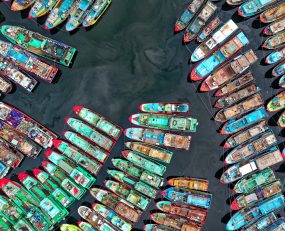
Jakarta is predicted to reach a population of 35.6m by 2030, which would rank it as the world’s largest megacity. Companies, including OOCL and Cargolux, have both made recent investments in the capital, stating that they wish to take advantage of the country’s growing e-commerce market and utilise the government’s plans to transform the country into a major logistics hub. Considering the network of ports and airports in close proximity to the capital it would appear that Jakarta is a wise investment however, several barriers diminish Jakarta’s attractiveness as a logistics hub.
e-commerce in Indonesia has vast potential for growth. Some estimates suggest that the e-commerce market in Indonesia is expected to grow from $27bn in 2018 to $300bn by 2025. Internet penetration is only around 50% according to the Association for Internet Service Providers, but users are generally young, tech-savvy and comfortable with online purchases. Indonesians also have a number of other online sales channels to choose from. Additionally, there are estimates to suggest that the number of online shoppers in Indonesia will increase by nearly 40%. The population is becoming more confident with online payments and disposable incomes are growing which could prove beneficial to providers should they invest in the capital.
However, the poor infrastructure present in Jakarta has hindered growth. Traffic congestion in Jakarta is infamous. Infrastructure development, despite claims that it will be improved drastically, has been significantly hindered due to landowners either refusing to sell their land or demanding high prices. These disputes have resulted in many infrastructure projects being idle for years or cancelled altogether. As a result, logistics costs are higher, lead times are longer and service quality is lower, especially in more underserved locations.
Additionally, Jakarta is sinking with some estimates suggesting that 95% of the capital will be underwater by 2050. In light of these challenges, the President has announced plans to relocate the capital. The new city will be built across two regencies; Kutai Kartanegara and Penajam Paser Utara in the region of East Kalimantan. The work is expected to begin in 2024 and will cover approximately 180,000 hectares, three times the size of Jakarta. The area is also not as exposed to natural disasters which plague other parts of Indonesia and is in close proximity to urban areas that are already developed – the cities of Balikpapan and Samarinda.
This new city may present many opportunities for logistics providers so long as that city planners learn from the lessons that Jakarta’s example offers. The UN has reported that big cities generate wealth via the creation of new jobs. The government hopes that moving the capital to the country’s less developed east will promote economic growth. However, many people move to cities before infrastructure is built to sustain them. The government therefore faces the challenge of anticipating and keeping pace with population growth and develop infrastructure which will support and encourage the economic growth that cities can offer.
Changing the country’s capital is not unusual, Brazil, Nigeria, and Myanmar have all relocated their capitals. The sheer size and complexity of megacities like Jakarta give rise to enormous social and environmental challenges. A lack of proper planning and rapid urbanisation have hindered Jakarta’s development as a logistics hub, so far stopping it from fulfilling its potential. The government seems determined to ensure that the new capital will not face the same challenges as Jakarta. The new city is not expected to be completed for another ten years so only time will tell whether or not it will succeed. What is clear is that the lessons are there to be learned, and the size and scale of the opportunity for logistics providers and other investors are being shaped by decision taken here and now.
Source: Transport Intelligence, October 3, 2019
Author: Beth Poole